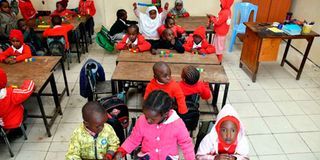World Bank lauds Kenya schooling. Surprised?

World Bank recommended that other countries in the region look to Kenya for lessons on how to improve their education systems.
Earlier this month, the World Bank had some nice things to say about the results of Kenya’s education reforms. Although it noted a boatload of problems that plague it, WB noted a marked improvement in literacy and arithmetic despite challenges like crowding and the Covid-19 disruption. Kenyan students are also posting improved learning outcomes, performing better than their peers in the East African region.
It’s a dramatic change of fortunes. Until about 15 years ago, Kenyan students were over-running Ugandan schools as parents sent them to study away from a broken system. The exodus led to an explosion in private schools and a whole sub-economy built around the students. Not anymore.
Kenya split the years spent in school through the Competency-Based Curriculum (CBC) with emphasis on practical learning, not just studying to pass examinations. Pupils previously spent eight years in primary school and four in secondary. They now spend six years in primary school and three each in junior secondary and senior secondary. More money has been invested in teacher training, school textbooks, connecting schools to electricity and better school management.
Rare praise
The thing is, some of these reforms have been tried elsewhere in Africa and the results have, in some cases, been worse than before. Reporting on the WB’s plaudits, The EastAfrican weekly called it “rare praise”.
It’s rare because good outcomes from well-meaning tinkering with education are scarce. If you built a hospital, staffed it with diligent nurses and doctors, stocked it with medicine (ensuring it isn’t stolen) and kept the lights on, patients will troop in and you will have improved health outcomes. If you did the same with a school, you infrequently get better results.
Some years ago, we were travelling in rural Uganda when we stopped at a market under a cluster of giant mango trees to buy roasted maize. To our right was a grass-thatched miserable-looking village primary school, but it was full of life. Cheerful and loud children were running about during the break. Directly opposite it was a beautiful school with a shiny metal roof, white walls, nice football field, latrines and the works. It was silent.
Curious, we inquired why there were no children at the modern school, which, we learnt, was government-owned. The folks in the market told us that it used to turn out poor results in the national exams; the teachers were not always paid on time, and the headmaster was a hopeless fellow.
The nearby villages abandoned it and moved to the grass-thatched one, which had decent exam results. The poorly paid teachers also crossed over and started moonlighting there. The village cows roamed the modern school’s playground, feeding on the grass, as the children played happily on dusty grounds across.
The contrast was surreal.
Schools are like markets. Politicians campaign big on markets, promising mobile and roadside vendors facilities fit for the 21st century. And, sure enough, in Kenya and around Africa, many new markets have been built. Many of them have failed. In Kenya, several are white elephants being eaten up by bushes.
User experience
The problem is that governments don’t understand a thing about user experience, don’t get consumer behaviour and have no clue about vendor economies. The “small fee” they are asked to pay for stalls is what used to be the vendors’ profit.
Well-paid teachers are of little use if they are not good teachers. A good teacher can’t be got only through a good salary. A school can have all the textbooks in the world but that doesn’t mean students will read them. Or if they do, that they will be helped by them. They are good things, to begin with, though.
WB recommended that other countries in the region look to Kenya for lessons on how to improve their education systems. But if the reasons for success are so hard to put a finger on, one has to wonder how much use that can be. I’ve a suspicion that after building, changing curricula, upping the quality of teachers, stocking up on books and all those things, what happens outside the school might be a significant contributor to learning outcomes.
Fire up the imagination
I think building highways, real estate booms, nice cars on the roads, increased lighting, proliferation of bright things like screens (TVs), malls and supermarkets with an array of brightly packed products, Sunday church services with well-dressed beautiful people, Friday Muslim Jummah prayers with worshippers in bright expensive starched white gowns, neighbourhoods with well-trimmed hedges and lawns and clean safe streets fire up the imagination and add up to create a positive factor to enable students to do well.
If you look at places like Ghana, Sierra Leone and Rwanda, where education has improved, you get the sense that what is happening outside the school fence is as definitive as what is happening inside.
Mr Onyango-Obbo is a journalist, writer and curator of the “Wall of Great Africans”. @cobbo3





